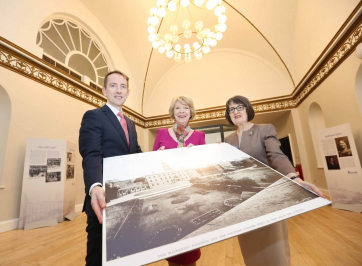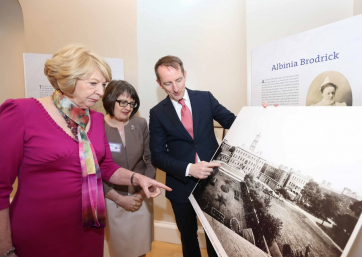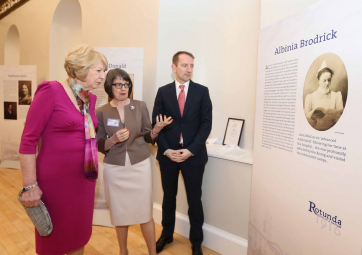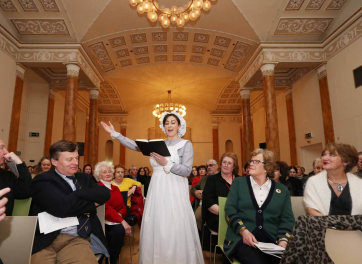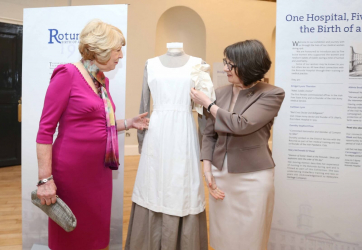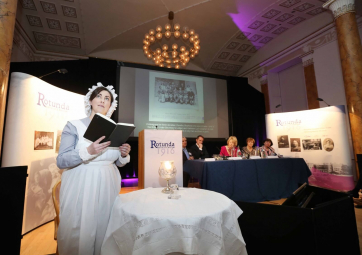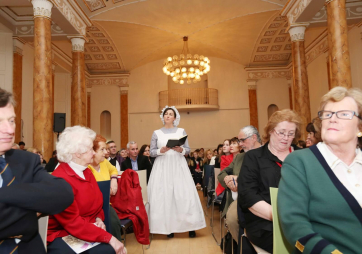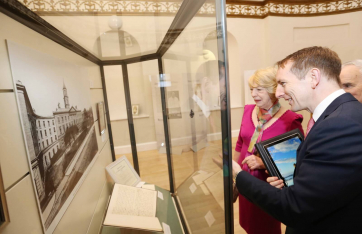Speech at the National Flag Presentation Ceremony
Croke Park Stadium, Dublin, 7th March 2016
A Ardmhéara,
A Aire,
A Dhaoine Uaisle,
Agus a Dhaoine Óga agus a Dhaltaí Scoile ach go háirithe,
Tugann sé ardú croí dom na mílte dalta scoile ó cheann ceann na tíre, agus a múinteoirí, a fheiceáil le chéile anseo ar fód beannaithe Pháirc an Chrócaigh. Mar Uachtarán na hÉireann, tá áthas orm a bheith anseo chun an ócáid speicialta seo a roinnt libh, ócáid inar féidir linn smaoineamh siar ar an stair agus ar thábhacht siombailí bhunaidh an stát, Bratach na hÉireann agus Forógra Éirí Amach na Cásca 1916.
Tá súil agam go mbeidh cuimhní na hócáide shollúnta seo ag gach aon duine óg atá anseo ar maidin ina chuireadh chun ionspioráid a ghlacadh ón phaisean, ón misneach agus ó ardmhían fial na tírghráthóirí Éireannacha a tháinig romhainn, agus go dtógfaidh sibh an cúram oraibh féin Éire na todhchaí a shamhlú.
It is so impressive to see pupils from hundreds of schools across Ireland come together to share in this very special occasion. Today each of your schools will receive two important symbols of our Irish nation – the Tricolour and the 1916 Proclamation. Today we will recall the ideas, the hopes, the dreams, of those men and women from our past who decided to fight for the freedom of Ireland. We will reflect, together, on what it was that motivated around a thousand women and men to take part in the Rising of Easter 1916 – some of them, members of the Fianna, or boys from Padraig Pearse’s school, Saint Enda’s, who were no older than those of you who are in fifth and sixth year.
It must have been a surprising sight indeed for those on the streets of Dublin around midday on that Easter Monday holiday to see members of the Irish Volunteers, the Irish Citizen Army, Cumann na mBan and the Fianna make their way, as one account of the time puts it, “in gloriously fine sunshine,” towards their positions in various locations across Dublin city. The largest contingent, led by James Connolly and Padraig Pearse, left Liberty Hall on foot, with Tom Clarke and Séan MacDermott travelling ahead by car. Joseph Plunkett, who was just after an operation, was brought to the GPO and placed to rest inside, in front of the stamp counter. Countess Markievicz, with her Irish Citizen Army uniform, also attracted attention. It must have been a dramatic scene, and that was no coincidence as many of the leaders of the Rising had experience in working in the theatre.
On that Bank Holiday, when many Dubliners were making for trains to bring them to the races, the seaside, or the country, this determined group of men and women were getting ready, then, to strike against the British Empire and proclaim an Irish Republic.
These rebels had concluded that the parliamentary path advocated by many others within the nationalist movement had little real prospect of delivering independence for Ireland, and they were willing to sacrifice their lives in an exemplary way for the greater cause of Irish freedom.
It is important to recognise that those men and women who were “out” in 1916 were selfless in their aspirations for Irish independence. They may have differed in the ideals they emphasised: some gave priority to workers' rights, others to the rights of women, yet others were concerned with Ireland's cultural identity and the revival of the Irish language. Yet all of them, with their different ideas for the future of the nation, came together to pursue what they shared, a dream of independence, and they did so at an enormous personal cost for themselves and their families.
The Proclamation of the Republic, which Patrick Pearse read out at around 1 o'clock that same Monday from under the porch of the GPO, offers elements of a generous social and political vision that can still inspire us. Addressed to the nation's women as well as its men, it called forth a Republic that would guarantee, I quote:
"religious and civil liberty, equal rights and equal opportunities to all its citizens” and be resolved “to pursue the happiness and prosperity of the whole nation and of all its parts, cherishing all the children of the nation equally.”
In an era when, we must remember, women did not have the right to vote, the Proclamation also asserted that the government of Ireland’s new Republic would be "elected by the suffrages of all her men and women."
Just before Pearse started reading out this Proclamation, a green, white and orange banner – the Irish Tricolour – had been hoisted by the insurgents onto the roof of the GPO, alongside another large green flag inscribed with the words "Irish Republic". It is testament to the enormous success of the Easter Rising in capturing the imagination of the Irish people that the Tricolour flag which, at the time, was little known even among the rebels, rapidly became accepted as the unquestioned symbol of the Irish independence movement. Two decades later, when our Constitution was adopted, it stated, in Article 7, that:
"The national flag is the tricolour of green, white and orange."
But what is the meaning of this flag around which we are gathered today? Where did it come from? As the theatrical performance we saw earlier related, the Irish Tricolour was flown for the first time by a member of the Young Ireland movement, Thomas Francis Meagher, in Waterford, on 7th March 1848.
Modelled on the French Tricolour, a symbol of the French Revolution and the principles of freedom, equality and fraternity that it proclaimed, the Irish Tricolour takes us back to the roots of the modern democratic movement. It connects us to the seminal year of 1848, to that extraordinary period of effervescence when, throughout Europe, ideas about democratic participation, freedom of the press, workers' rights, and the political and cultural rights of colonised nations were proclaimed and exchanged. The design of the Tricolour thus places Ireland firmly in the great tradition of independent European republics.
In April of that same year of 1848, at a meeting in Dublin, Thomas Francis Meagher outlined the significance of the particular arrangement of colours he wished to see adopted as the emblem of the Irish nation:
“The white in the centre signifies a lasting truce between Orange and Green and I trust that beneath its folds the hands of Irish Protestants and Irish Catholics may be clasped in generous and heroic brotherhood.”
Later in his life, reflecting on his youthful years in Waterford, Thomas Meagher wrote:
"May the social institutions flourish which bring Irishmen together, make them know each other, trust each other, love each other, and, in convivial circles, teach them they are brothers all!"
Thus our national flag is primarily an emblem of peace, a call for solidarity, mutual trust, sisterhood and brotherhood, to become the enduring symbols of the Irish nation. This is indeed a vision worth championing, an ideal we must continue to cherish and nurture.
As we commemorate, this year, the centenary of the Easter Rising, this ideal should continue to inspire us. While we acknowledge the motivations that led the rebels to act as they did a hundred years ago, we recall, too, the human suffering associated with this armed rebellion. We remember, not just the rebels, but also the many civilians who lost their lives during that Easter Week, the children who were wounded or killed in the crossfire, the families who were grief-stricken by the loss of a loved one. And in doing so, we must also commit to ensuring that, never again, is such loss of life allowed to take root in our country.
Today the Irish Tricolour is recognised everywhere, both inside and outside of Ireland, as a distinctive marker of Irish national identity and culture. It is a symbol we exhibit to manifest our pride at sporting events, and we all look forward to witnessing, later on, the presentation of our national flag to some of our sporting heroes. The Tricolour is also an emblem of generous, inclusive Irishness – one we readily share with others, for example on Saint Patrick's Day, when so many people around the world wear the Irish colours.
Last year, at a similar flag presentation ceremony in Waterford, I suggested that, while in 1848 and in 1916 the emphasis was on the fraternity between the ‘orange’ and the ‘green’ traditions on our island, nowadays, the white can play an even greater role in embracing as one nation the diverse and rich tapestry of people from various cultures who call Ireland their home.
Is mian liom a rá arís go bhfuil áthas orm an lá speicialta comóraidh agus cuimhneacháin seo a chaitheamh libh. Tá an-tábhacht ag baint leis an stair, mar ábhar scoile agus mar bhunchloch don todhchaí. Le tuiscint ar an stair, is féidir linn aire a thabhairt do na rudaí a fágadh againn ag na glúnta a tháinig romhainn, ár n-institiúidí, ár mbailte agus ár sráidbhailte, ár dtírdhreach agus ár dteanga álainn Gaelach. Má thugann muid aire mhaith do na rudaí seo ar fad beidh muid in ann todhchaí níos fearr a shamhlú.
May I say, once again, how pleased I am to share with you in this special day of celebration and remembrance. Conscious of our history, we are invited to care for the things that were handed down to us by the generations who preceded us – our institutions, our towns and villages, our landscape, our beautiful Irish language – so as to be better able to imagine alternative futures.
In this task, our young people have a great part to play. We need your ideas, your enthusiasm, your dreams, to continue the work of building, together, a society in which all of our citizens can flourish. We need your creativity, your generosity and energy to respond to the great challenges of our time, such as climate change, global poverty and hunger, or the ongoing refugee crisis.
The Easter Rising of 1916 can, in many ways, be described as a stunningly ambitious act of imagination. Today it is up to our young people to take charge of change and imagine what Ireland might yet become.
Go raibh míle maith agaibh go léir.

